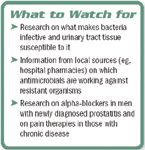Article
New agents to fight UTI, prostatitis slow to emerge
At the upcoming AUA annual meeting, urologists will see newconcepts emerging from research in both urinary tract infection andprostatitis, but those will take some time to produce newtherapies, cautioned Anthony J. Schaeffer, MD.
At the upcoming AUA annual meeting, urologists will see new concepts emerging from research in both urinary tract infection and prostatitis, but those will take some time to produce new therapies, cautioned Anthony J. Schaeffer, MD.

Basic research on UTIs continues to reveal what makes bacteria infective and what makes urinary tract tissue susceptible to it. It is also felling the old model that each UTI is a new event. Infective bacteria, researchers are finding, can actually multiply within bladder urothelium and emerge to reinfect the urinary tract.

"There should be firm evidence that there's an infection, and urologists should be careful about adherence to the guidelines-the duration and the dosing-3 days of therapy, for example, for uncomplicated UTIs, not 7 days.
"Antimicrobials should not be used prophylactically when not indicated, and there are guidelines available on that, too."
If urologists do these two things, said Dr. Schaeffer, they have a much better chance to deal with susceptible organisms when the patient does have an infection.
Follow-up required
Given that resistant organisms are more common, not following up carefully on patients after prescribing empiric antimicrobials can be disastrous, he warned. Urologists will have to pay more attention to their patients after they are started on therapy to avoid those untoward events.
Don't assume that the antimicrobials you have been using will be effective today, so familiarize yourself with the drugs that are working in your practice environment, Dr. Schaeffer advised. For example, some drugs that became ineffective and fell out of use, such as cephalexin (Keflex), may again be effective. Consult your hospital pharmacy for information on what's working.
In addition, Dr. Schaeffer advised looking at the patient's risk factors.
"If patients have been in the hospital or have been recently exposed to antimicrobials, you should recognize that they may have resistant organisms, and be particularly careful both in obtaining the diagnosis by doing a culture and monitoring the patient for response to therapy," he said.
Challenges in CP/CPPS
Reflexively prescribing antimicrobials is something urologists should avoid in men with chronic prostatitis/chronic pelvic pain syndrome (CP/CPPS), said Dr. Schaeffer.
Without new therapies for CP/CPPS, urologists have to treat empirically, but well-controlled studies have established that current therapies, especially antimicrobials in the absence of proven infection, aren't effective. Epidemiologic studies show that about 5% to 10% of men have CP/CPPS, he noted. Symptom scores, such as the NIH chronic prostatitis symptom index (NIH-CPSI), which has been validated in many languages, can help urologists get a handle on the extent of the patient's problem and help you judge whether therapies are working.





